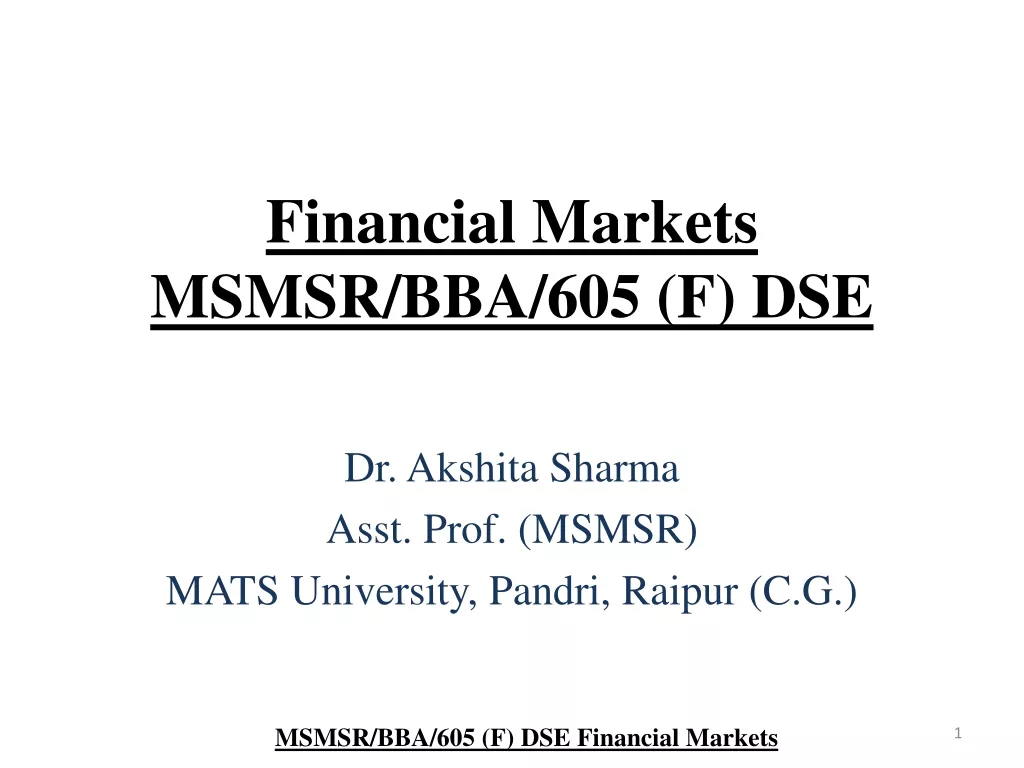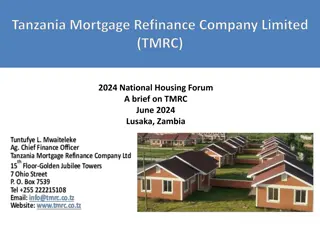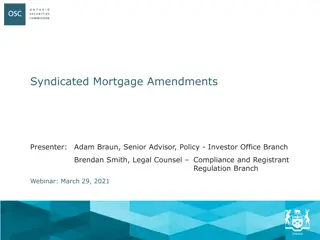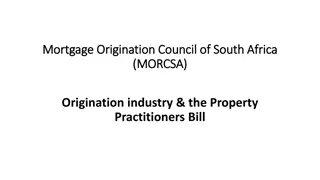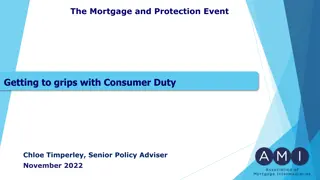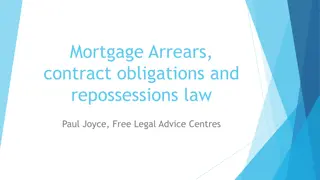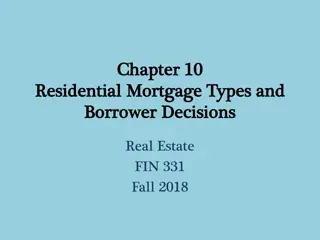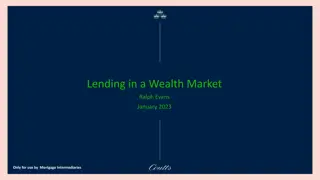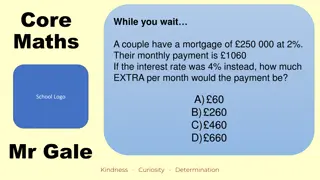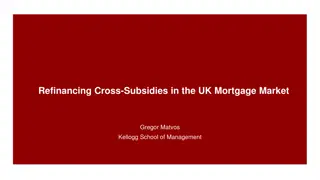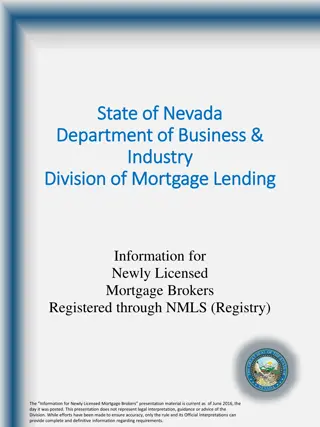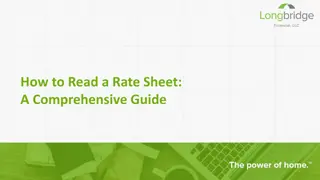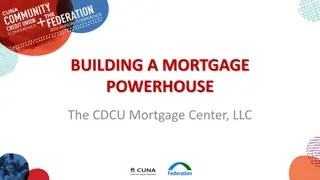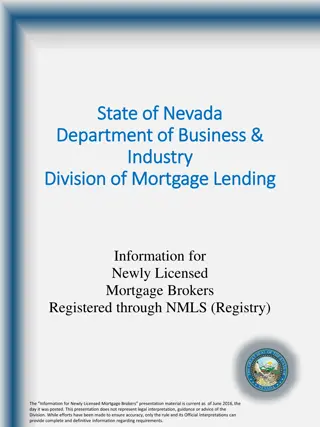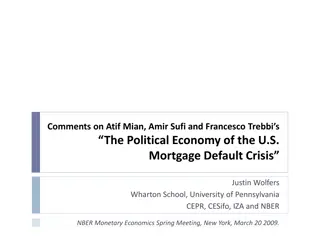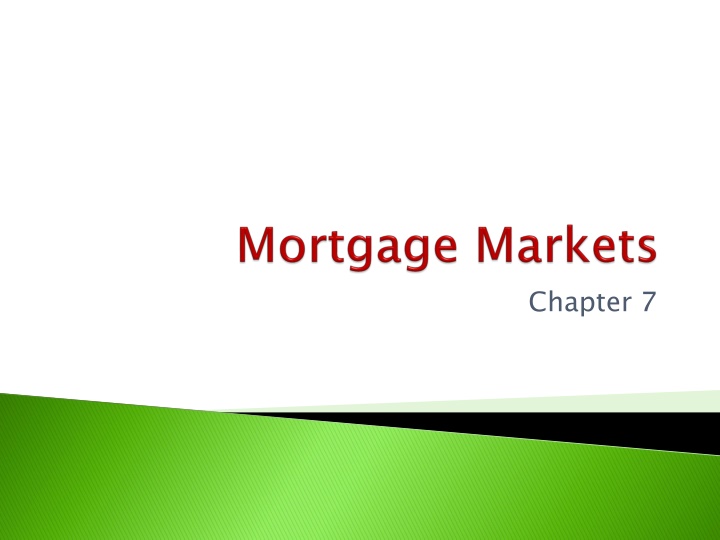
Mortgages: Types, Backing, and Characteristics
Explore the world of mortgages, including different types such as home, commercial, and farm mortgages. Learn about how mortgages are backed by specific properties and the characteristics of primary mortgages compared to stocks and bonds. Discover the role of capital market instruments in determining loan qualifications and the importance of collateral in mortgage agreements.
Download Presentation

Please find below an Image/Link to download the presentation.
The content on the website is provided AS IS for your information and personal use only. It may not be sold, licensed, or shared on other websites without obtaining consent from the author. If you encounter any issues during the download, it is possible that the publisher has removed the file from their server.
You are allowed to download the files provided on this website for personal or commercial use, subject to the condition that they are used lawfully. All files are the property of their respective owners.
The content on the website is provided AS IS for your information and personal use only. It may not be sold, licensed, or shared on other websites without obtaining consent from the author.
E N D
Presentation Transcript
Loans to individuals or businesses to purchase a home, land or other real property. Categories of mortgages Home mortgages Multifamily dwelling mortgages Commercial mortgages Farm mortgages
Mortgages Backed by specific piece of real property. If borrower defaults, FI can take ownership of property Mortgages Stocks and bonds Give a general claim on borrowers assets Only mortgage bonds are backed by a specific piece of property that allows the lender to take ownership in the event of a default. Stocks and bonds
Mortgages Primary mortgages have no set size or denomination. Size of each mortgage depends on the borrower s needs and ability to repay Mortgages Stocks and bonds Bonds denomination $1,000 or multiple of $1,000 per bonds Shares of stock $1 per share Stocks and bonds
Mortgages Primary mortgages generally involve only a single investor Mortgages Stocks and bonds Bonds and stock issues by many investors Stocks and bonds
Mortgages Comparatively little information exists on mortgage borrowers, since borrowers are individuals Mortgages Stocks and bonds Bonds and stocks are issued by publicly traded corporations, hence subject to extensive rules and regulations Hence information is available Stocks and bonds
Capital market instruments Contract between a financial institution and a borrower Contract specifies characteristics of the mortgage agreement When a FI receives mortgage application, it must determine whether the applicant qualifies for a loan
Backed by a specific property serves as a collateral FI will place lien fully paid off Nobody can buy the property and obtain a clear title Lien is a public record attached to the title of the property with public recorder s office that gives the FI the right to sell the property if the borrower defaults or falls into arrears lien against property until loan is
Mortgage borrower pays a portion of purchase price of the property on the day mortgage is closed. Balance of the purchase price is the face value of mortgage (Loan proceeds) Decreases default risk for the FI How?
A mortgage borrower who makes a large down payment invests more personal wealth into the home Less likely to default if the property value falls Value of the property is more than the mortgage loan
Size of down payment depends on the financial position of the borrower Generally 20% is down payment Loan to Value ratio may not be more than 80% Borrowers who pay less than 20% purchase private mortgage insurance
Purchased by the lender (FI) and paid by the borrower as part of monthly payment In the event of default, PMI issuer guarantees to pay the FI the difference between value of the property and the balance remaining on the mortgage. If the property value increases or mortgage is paid PMI may be removed by the FI
Originated by FI Repayment guaranteed (fee 0.5% of loan amount) by Federal Housing Administration (FHA) or Veterans Administration (VA) Loan applicants to meet specific requirements set by these govt. agencies Available only to individuals from military services Maximum size of the mortgage is limited depending on location and cost of living Require either a very low (3%) or zero down payment
Not federally insured If down payment less than 20%, privately insured Secondary market mortgage buyers will not buy conventional mortgages if Loan-to-value ratio more than 80% Not privately insured
Generally 15 or 30 years 15-year more popular 15-year mortgage offers potential savings in interest paid However, monthly payments are higher
Fixed principal and interest payments fully pay off mortgage by its maturity date. During the early years of mortgage, most of the fixed monthly payment represents interest on the outstanding principal and a small amount represents payoff of the outstanding principal As mortgage reaches maturity, most of the payment represents payoff of the outstanding principal and a small amount represents interest Reduces default risk
Shows how the monthly mortgage payments are split into principal and interest
Interest payment for 3 to 5 years Full payment of mortgage principal at the end of the period Default risk is high
Most important characteristics Mortgage borrowers choose how much to borrow and from whom based on interest rates
FIs base their quoted mortgage rates on several factors 1. Market rates at which FIs borrow (rate on certificate of deposit or Federal funds rate) 2. Rate on specific mortgage loan depends on whether it is a fixed or variable rate of interest or loan specifies discount points
Locks in interest rate, regardless of market rate changes
Interest rate tied to some market rate Required monthly payments can change over the life of mortgage
Payment made when mortgage loan is issued One discount point paid up front is equal to 1% of the principal FI reduces interest rate in exchange of discount point Borrower weighs reduced interest payment over the life of loan versus upfront payment Decision depends on the period of time the borrower expects to hold the mortgage
Borrower takes a new mortgage and uses the proceeds to pay off the current mortgage Done when interest rate falls Decision involves balancing the savings of a lower monthly payment against the costs (fees) of refinancing Thumb rule interest rate should fall by 2 percentage points of more
A type of fixed-rate mortgage clause that entitles the borrower to reduce fixed-interest-rate and early in the mortgage The option will be exercised when interest rates fall lower rate Unlike variable rate mortgages, in this mortgage type interest rate only falls and does not increase This is to keep off from refinancing when interest rates fall rate mortgage, which contains a reduce the mortgage once, rate charge on the mortgage mortgage. rates lower then the borrowers initial mortgage rate mortgage
Small payments early in the life of mortgage Payments increase over first 5 to 10 years Final payments level off at the end of the mortgage Used by borrowers who expect their income to rise The advantage of the GPM is that borrowers will qualify for a larger loan than if they requested a conventional mortgage Default risk high
Initial payments same as conventional Increase over a portion or entire life of the mortgage Increase in monthly payments reduces the principal quickly and reduces the actual life of mortgage In contrast to Graduated payment mortgages, which do not mortgage is paid off, in GEM incremental increase in monthly payments reduces the actual life of the mortgage affect the time until the Dr. Lakshmi Kalyanaraman 28
Already a security in first mortgage Loan is secured again Should a default occur, the second mortgage holder is paid only after the first mortgage is paid off Interest rates on second mortgages are generally higher than the first mortgages
Second mortgage only from home equity built Home equity loan line of credit secured with a second mortgage by customers Home equity = current market value of the home-outstanding mortgage balance
Mortgage interest at a rate less than the current market rate in exchange for share in property value appreciation If property sold for more than the original purchase price, FI shares the gain FI shares the gain Dr. Lakshmi Kalyanaraman 31
Similar to Share appreciation mortgage Instead of FI, an outside investor share appreciation The investor either provides a portion of the down payment on the property or Provides monthly payments an outside investor share the Dr. Lakshmi Kalyanaraman 32
Borrower receives regular monthly payments from a FI When RAM matures or borrower dies, property is sold and debt retired Dr. Lakshmi Kalyanaraman 33
After FIs originate mortgages, they sell or securitize them in secondary mortgage market. Reduces liquidity risk, interest rate risk and credit risk of their portfolios Dr. Lakshmi Kalyanaraman 34
Liquidity Risk: Depository institutions obtain majority of their funds from short-term deposits. Mortgage maturities are of 15 or 30 years Liquidity Risk: Dr. Lakshmi Kalyanaraman 35
Interest Rate Risk: Holding long-term fixed rate mortgages subject them to interest rate risk, if interest rates are expected to rise Interest Rate Risk: Dr. Lakshmi Kalyanaraman 36
Credit Risk Since mortgage maturities are of 15 or 30 years, FIs face the risk that promised cash flows from loans may not be paid in full Credit Risk: (Default Risk)
Many of the institutions making mortgage loans do not want to hold large portfolios of long-term securities. Commercial banks, for example, obtain their funds from short- term sources. make money through the fees that they earn for packaging loans for other investors to hold. Loan origination fees are typically 1% of the loan amount, though this varies with the market. Dr. Lakshmi Kalyanaraman 38
Once a loan has been made, many lenders immediately sell the loan to another investor. The borrower may not even be aware that the original lender transferred the loan Some of the originators also provide servicing of the loan The loan-servicing agent collects payments from the borrower, passes the principal and interest on to the investor, keeps required records of the transaction servicing of the loan.
Servicer keeps formal records of mortgage transaction For the service, FI collects a monthly fee Fee ranges from to percent of the mortgage balance Dr. Lakshmi Kalyanaraman 40
FIs remove mortgages by 1. pooling all recently originated mortgages together and sell them in the secondary mortgage market 2. issuing mortgage backed securities i.e. securitization of mortgages Dr. Lakshmi Kalyanaraman 41
FI sells loans to manage their credit risk better Removes assets (and credit risk) from the balance sheet Allows FI to achieve better asset diversification Allows FI to better manage interest rate risk and liquidity risk Generates fee income Reduces the cost of reserve requirement Reduces the cost of holding capital requirements against mortgages
Securitization of mortgages involves pooling of a group of mortgages characteristics Removal sheet Subsequent sale pool to secondary market investors Securitization results in the creation of mortgage backed securities, traded in the secondary markets pooling of a group of mortgages with similar Removal of these mortgages from Balance sheet Subsequent sale of interests in the mortgage from Balance traded in the secondary markets
FIs asset portfolios more liquid Reduces interest rate risk and credit risk Source of fee income Reduces the effect of regulatory constraints such as capital requirement Dr. Lakshmi Kalyanaraman 44

